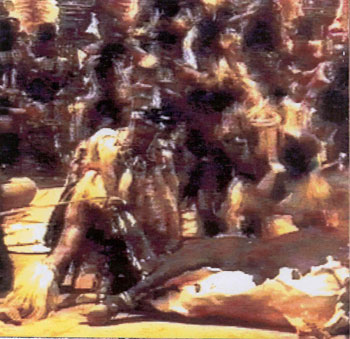Ukweshwama - Zulu bull-killing ritual
Zulu King Goodwill Zwelithini has a number of ceremonies conducted at his palace in Nongoma, his only traditionally-built palace.
Zulu ceremonies
Zwelithini, the sixth zulu king since Shaka and his brothers carved out a piece of South Africa for themselves in the mid-1800’s, is the first one to have to deal with the modern media and concepts like Human Rights.
He has a bull-killing ritual, scheduled this year for December 5. He is being taken to court over the perceived cruelty to the animal concerned.
I witnessed the ceremony on 2007, and can categorically say I saw nothing like what the ASA accuses :- men pulling out the bull’s tongue, stuffings and in its mouth or trying to tie its penis in a knot. Good grief.
I visited the ceremony with, among others, an activist who was gathering information for just such a court attempt. I spoke to him about it at that time.

The ritual
The Zulu kraal is a sacred place. It is the place where the cows are kept at night - both for safety and as a means to collect their dung for use as fertiliser or building materials. Women are not allowed in the Kraal, except for a sangoma during any ceremony. A deceased family leader is often buried in the kraal.
The Zulu king has a number of palaces scattered around Zululand, but his palace at Nongoma is his only traditional palace, built as a larger version of the traditional Zulu homestead. The kraal is huge, traditionally fenced with a thick, woody fence of living trees. Inside at the top end (all kraals are built on a slope) there is a small hut used in ceremonies by the sangoma.
Boys become men
Zulus do not have a circumcision ceremony, like the Xhosas, but they do have a coming of age ceremony. We saw about 15 young men come from the small hut with the Sangoma - white painted on their faces, and wearing traditional costume. They were greeted by the king, but were obviously shit-scared.
Picking of the bull
Loudspeakers informed us that cameras were not allowed. Everyone checked the few white people there.
First, the king viewed over the bulls (technically a steer - a castrated male - but I am going to use bull here) in the kraal. He picked one out, and now it was the job of the herdsmen to single it out to remain in the kraal. The bull pretty soon figured out that all was not well - as they circled the kraal other bulls were let out, but not him. He stuck like glue to a small knot of other bulls, but was eventually separated from them.
He was quite big. He was angry. He pawed the ground. The laaities (Afrikaans for boys) assembled uncertainly. They rushed the bull, but didn’t bother him. He rushed them - they ran. Some more back and forth. Then the bull hooked one of the boys and tossed him. The others rescued their comrade, but then the bull had figured out how to get out of the kraal - and did so.
Round 1 - to the bull.
Round 2
Obviously things could not remain like this, but the laaities were excused from the task - they were obviously not up to it. The bull was found again, and after half an hour was back in the kraal - tired now. They are not used to exercise. The other zulu men - older, much more numerous - came in to the kraal. The bull was no match for their number. Someone did the right thing -lifted a back leg, and tripped the animal. They sat on the beast - fifty people? You could not see the bull. They twisted the neck until it broke. The bull was dead.
My activist friend had a stopwatch - he said the bull took 20 minutes to die.
My conclusion
A bull suffered for 20 minutes. A group of zulu boys was traumatised for life. OK - I exaggerate - but one of them at least will never forget the momen the was tossed by a bull as the king looked on. Let them have their ritual. Postscript: You might also like to read this opinion piece.
Update: The court says the ceremony can go ahead.